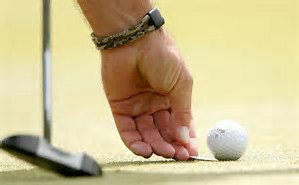On Sunday afternoon in Ireland, professional golfer Jon Rahm sailed to an easy victory in the Irish Open. Along the way, though, he was confronted by a rules official about a possible improper marking of his golf ball on the sixth green as he attempted to get out of the line of his playing competitor, Daniel Im.
After discussing the matter briefly with Rahm several holes later, the golfer was not assessed a penalty. The 22-year old Jon Rahm has become a bit famous on the PGA tour for his exceedingly quick temper, so I was curious to see how he might react if assessed the one-stroke penalty by the rules official. In this case, no penalty = a relieved professional golfer.
Just a few months ago, the LPGA’s Lexi Thompson was assessed four penalty shots after being told by a rules official that she had improperly marked her ball – on the previous day! It seems that a television viewer (yes, that’s correct) contacted the tournament and said that Lexi had not replaced her ball in the same spot where it originally came to rest. Since the round had been completed but the LPGA officials still deemed this a rules violation, the heartbroken Thompson was not disqualified but ultimately lost the ANA Inspiration tournament in a playoff.
Remember, these are professional golfers who are having all of this trouble marking a golf ball on the green. The rules of golf (and there are far too many of them) require the player to mark a ball if it interferes with the line of another player. The ball must then be returned to the spot where the ball initially came to rest.
Sounds simple enough, right? If the player believes that he or she did NOT do it properly, though, the player should call a one-shot penalty on himself/herself. Golf is really unique in that players are expected to observe all rules (no matter how odd they may seem) and penalize themselves if they break (purposely or not) any rule.
In this post-Tiger Woods and, sadly, the end of the Phil Mickelson era, golf now has both an identity problem (not enough household names every week) and a slow-play problem. You and I are expected to play a round of golf in under four hours. Have you noticed that the professional golfers on television are now taking up to five hours to complete a round of golf? These are the golfers who are paid prize money to hit the majority of fairways and greens (unlike the majority of us) so they should be able to play faster, right?
Here’s a simple suggestion to speed-up play and help future ball-marking incidents from cropping-up. Golfers should be required to continue putting until their ball is in the hole. Today’s professionals are marking their putts from as little as one foot from the hole instead of just quickly finishing-up. Once the player has seen the line of the first putt, then the second (or third, etc.) should be easier to determine without starting their “routine” (ugh) all over again after marking their ball. Since we now play in an era of spikeless golf shoes, golfers don’t have the excuse of being concerned by making spike marks while putting.
This change would definitely speed-up professional golf (’bout time!) and help reduce the increasing number of ball-marking spy-cam cases on television. Dear USGA – please do it!

